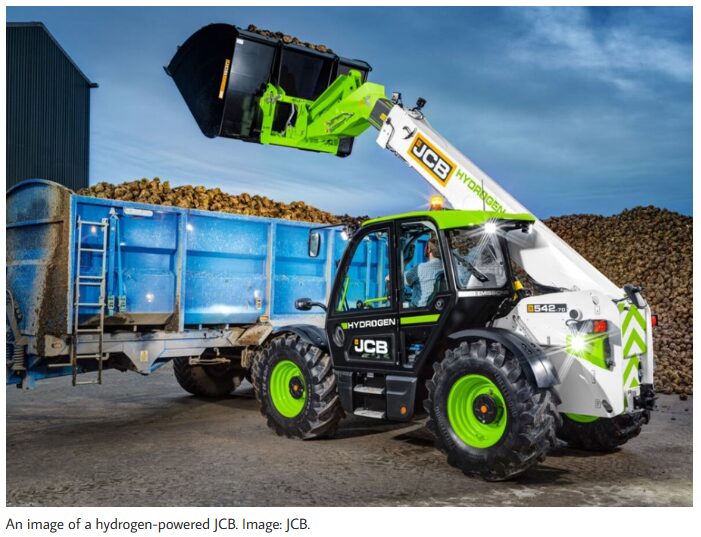Hydrogen powered diggers are here to revolutionise the UK’s construction industry; these innovative machines are setting the standard for what environmentally friendly earth moving can look like. In this blog we’ll examine the real need for calibration for manufacturing of hydrogen powered diggers and other earth moving equipment.
The digger revolution
Manufacturers, particularly JCB, have been working on how to effectively replace fossil fuels with a zero-carbon alternative while ensuring heavy machines can continue to perform their demanding tasks for extended periods. Traditional batteries were evaluated but deemed not practical due to their weight, cost, and limited charging capabilities, especially for equipment operating in remote locations or for long periods of time.
So, what exactly are hydrogen-powered diggers, and how do they work?
At their core, hydrogen-powered diggers utilise fuel cells to generate electricity, which then powers electric motors to drive the machinery. Unlike diesel engines, which emit harmful pollutants such as nitrogen oxides and particulate matter, hydrogen fuel cells produce only water vapor and heat as by-products, making them eco-friendly.
The process begins with hydrogen gas stored in high-pressure tanks on the digger. This hydrogen is then fed into the fuel cell stack, where it reacts with oxygen from the air to produce electricity. This electricity is used to power the digger’s motors, providing the necessary torque and horsepower to operate as required.
Hydrogen-powered diggers have been proven to offer similar performance to diesel counterparts while being much quieter and emitting zero emissions. This not only improves air quality on construction sites but also reduces noise pollution, benefiting both workers and local communities.
Hydrogen fuelling infrastructure is gradually expanding across the UK, thanks to government initiatives and private sector investments. As the likes of JCB manufacture more of these types of differs more construction companies are installing refuelling stations to keep their hydrogen-powered fleet running smoothly. Hydrogen can be produced through renewable sources such as wind and solar power, providing a sustainable solution for powering heavy machinery like diggers.
Calibrating the manufacturing of hydrogen powered diggers
The manufacturing of hydrogen-powered diggers has several components and systems that require calibration to ensure optimal performance and efficiency.
Here’s an overview of the essential calibration required:
Fuel Cell Stack
The heart of a hydrogen powered digger is its fuel cell stack. Calibration of the fuel cell stack is crucial to ensure that it operates efficiently and reliably. This involves fine-tuning the control systems to maintain the proper balance of reactants (hydrogen and oxygen) and optimisation of the electrochemical reactions within the fuel cell.
Electric Motors and Drivetrain
Hydrogen powered diggers use electric motors to drive the machine’s movements. Calibration of these motors and the drivetrain is necessary to achieve precise control over acceleration, speed, and torque. This ensures smooth and responsive operation while maximising energy efficiency which is important for alternative fuels.
Power Management Systems
Manufacturers need to calibrate the power management systems to effectively distribute electrical power from the fuel cell stack to various components of the digger, such as motors, hydraulics, and auxiliary systems. Proper calibration ensures that power is allocated efficiently based on demand and priority, minimising energy waste.
Hydrogen Storage and Delivery Systems
Calibration of hydrogen storage tanks and delivery systems is essential to maintain the optimal pressure and flow rate of hydrogen gas to the fuel cell stack. This involves monitoring and adjusting parameters such as tank pressure, valve opening/closing times, and gas flow rates to ensure a steady and reliable supply of hydrogen fuel.
Control Systems and Sensors
Hydrogen-powered diggers rely on sophisticated control systems and sensors to monitor various parameters such as fuel cell temperature, hydrogen concentration, battery status, and operational conditions. Calibration of these systems ensures accurate readings and proper functioning, allowing for safe and efficient operation of the digger.
Safety Systems
Calibration of safety systems is critical to ensure compliance with industry standards and regulations. This includes calibration of sensors for detecting hydrogen leaks, pressure relief valves, emergency shutdown systems, and other safety features to mitigate potential hazards associated with hydrogen use.
Performance Monitoring and Diagnostics
Manufacturers may incorporate onboard diagnostic systems to monitor the performance of the digger and identify any issues or inefficiencies. Calibration of these monitoring systems enables accurate data collection and analysis, facilitating proactive maintenance and troubleshooting to keep the digger operating at peak performance.
Proper calibration of various components and systems is essential for manufacturers to deliver high-quality, reliable, and safe hydrogen powered diggers to the market. It ensures that these innovative machines meet performance standards, maximize energy efficiency, and contribute to the advancement of sustainable construction practices.
JCB’s hydrogen powered journey represents bold thinking, innovation, and a commitment to sustainability. As Lord Bamford, JCB’s Chairman, aptly put it, “We’re proving daily that hydrogen does work, that it’s a clean, renewable, transportable fuel.” With hydrogen, JCB is paving the way toward a greener, more efficient future for heavy machinery. And CoMech are here to provide the calibration that’s required to get these diggers onto construction sites safely.


